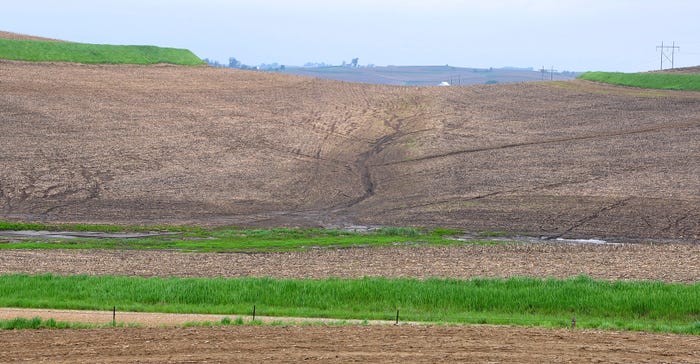September 28, 2018

By Jason Johnson
USDA’s Natural Resources Conservation Service has a new planning resource for farmers who are having problems controlling ephemeral gully erosion on their cropland. Conservation Choices: Controlling Ephemeral Gullies is the latest in a series of planning guides Iowa NRCS has developed to provide natural resource conservation solutions.
Ephemeral gullies are the small ditches in fields that farmers smooth with a disk before planting crops. Ephemeral gullies are natural drainageways that form in the same location after additional runoff events. When farmers fill in gullies they often use loose topsoil treated with fertilizer and herbicides. Erosion from ephemeral gullies can then contribute to excess phosphorus and nutrients in streams and rivers.
The new planning guide is part of an NRCS campaign called Fix It, Don’t Disc It, which encourages Iowa farmers to stop ephemeral gully erosion with conservation systems.
Best practices to choose and use
Iowa NRCS is promoting the following practices as the best ways to control ephemeral gully erosion:
• Grassed waterways. Grass or other perennial vegetation is planted where water usually concentrates as it runs off a field.
• Terraces. Earthen structures are built across the drainageway, which segments the ephemeral area into short sections. Terraces effectively shorten slope length and reduce the drainage area.
• Water and sediment control basins. Similar to terraces, these are built to form a sediment trap and water detention basin with a stable outlet.
• Critical-area planting. Establishing permanent grass or other perennial vegetation in areas with high erosion rates. Typically used for smaller areas.
Seasonal protection
Here are other practices to help with smaller gullies:
• No-till. Grow crops without disturbing or tilling the soil from planting through harvest. No-till is most effective in reducing ephemeral gully erosion in small watersheds with relatively wide and flat drainageways.
• Cover crops. Crops, such as cereal rye, wheat or oats provide seasonal cover and other conservation benefits to the soil. For ephemeral gully erosion, cover crops only provide annual or temporary protection and are most effective with a no-till system.
Practice maintenance
Properly maintaining conservation practices can be challenging for farmers due to the large size of newer farming equipment. The best practices for ephemeral gully erosion control often require perennial vegetation or proper spacing down the hillside.
The width of newer spray booms, for example, makes it difficult to keep herbicides from drifting to terraces and grassed waterways. Terraces, and water and sediment control basins also require shorter spacing from the top to the bottom of a hillside, which can make maneuvering spray equipment between terraces or basins difficult.
Here are a few maintenance tips for farmers and custom applicators:
• Turn off spray equipment when crossing grassed waterways.
• Do not plant crops along a grassed waterway. Instead, plant on the contour perpendicular to the waterway, making sure to lift the planter while crossing the waterway.
• Avoid driving through grassed waterways when it is wet or when water is flowing down the waterway.
• Do not spray chemicals on windy days and keep spray equipment far enough away from grass-covered terraces to avoid killing perennial vegetation.
• In full-field cover crop systems, allow early-season growth in areas susceptible to ephemeral gully erosion. Terminate those areas later with the second herbicide pass.
Meet erosion control standards
Since the passage of the 1985 Farm Bill, farmers have been required to annually control sheet, rill and ephemeral erosion on fields that are classified as highly erodible. Each spring, NRCS conducts compliance reviews on a random selection of highly erodible fields to determine if erosion has been adequately controlled.
State conservationist Kurt Simon says Iowa NRCS employees will work closely with farmers to help them meet erosion control requirements. He said that farmers may not be expected to complete changes immediately. “If erosion control issues are identified during general program assistance, producers may be given time to make adjustments and install needed conservation practices,” he says.
Simon says Iowa NRCS offers financial assistance to help farmers install or implement conservation practices. Landowners can sign up for voluntary farm bill conservation programs on a continual basis at their local NRCS office.
“NRCS staff are available to help farmers identify ephemeral erosion in their fields or where it may occur, and then assist them with applying the conservation practices that best fit their farming operations,” Simon says.
Meeting erosion control requirements may affect eligibility not only for farm bill program benefits, but also for federal crop insurance premium subsidies.
For more information, contact NRCS at your local USDA Service Center.
Johnson is public affairs specialist with NRCS in Des Moines.
You May Also Like




